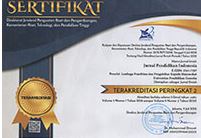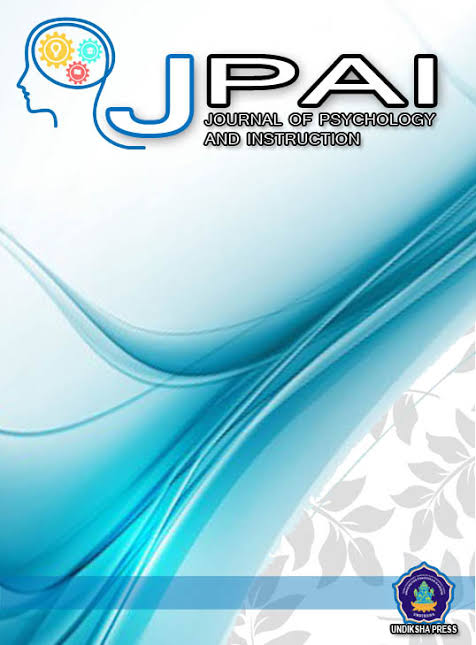Toxic Positivity in Adolescents: An Attitude of Always Being Positive in Every Situation
DOI:
https://doi.org/10.23887/jpai.v7i1.60616Keywords:
Toxic positivity, adolescents, positive attitude, empathyAbstract
Toxic Positivity is known as the concept of over-promotion of happiness. This concept believes that staying positive by ignoring negative emotions is the right solution in dealing with problems. This misconception about the concept of staying positive is certainly not by the fact that negative emotions are unavoidable in human life. The aims of this study is to analyze more deeply the meaning of the concept of toxic positivity, in terms of what those who experience toxic positivity think and feel, especially in the context of relationships. This qualitative research with a phenomenological approach focuses on the experiences of individuals with toxic positivity in their social relationship life, starting from what responses, feelings, and impacts arise when getting toxic positivity. Data collection in this study was conducted through interviews. The data obtained were then processed and categorized into the following themes. The findings show that toxic positivity is perceived as an inappropriate motivational response. The toxic positivity response elicits feelings of not being understood, anger, and disappointment, with negative impacts not only physically but also psychologically. The perpetrators are considered to come from individuals who have never experienced similar problems before and lack empathy. In addition, toxic positivity was also found in verbal abuse.
References
Ahmadi, M. R. (2017). The Impact of Motivation on Reading Comprehension. International Journal of Research in English Education, 2(1), 1–7. https://doi.org/10.18869/acadpub.ijree.2.1.1.
Arif, I. S. (2016). Psikologi positif: Pendekatan saintifik menuju kebahagiaan. PT. Gramedia Pustaka Utama.
Ashby, F. G., Isen, A. M., & Turken, U. (1999). A neuropsychological theory of positive affect and its influence on cognition. Psychological Review, 106(3), 529–550. https://doi:10.
Astalini, A., Darmaji, D., Kurniawan, D. A., & Ramadhanti, A. (2022). Mathematical Physics E-Module : Study of Students. Perception Based on Gender. Journal of Education Technology, 6(1), 91–101. https://doi.org/10.23887/jet.v6i1.42233.
Bambang Subiyakto, M. (2019). Internalisasi Nilai Pendidikan Melalui Aktivitas Masyarakat Sebagai Sumber Belajar Ilmu Pengetahuan Sosial. Khazanah: Jurnal Studi Islam Dan Humaniora, 17(1), 137–166. https://doi.org/10.18592/khazanah.v17i1.2885.
Batara, G. A., & Kristianingsih, S. A. (2020). Hubungan dukungan sosial dengan kesepian pada narapidana dewasa awal lajang. Jurnal Ilmiah Batanghari Jambi, 20(1), 187–194. http://ji.unbari.ac.id/index.php/ilmiah/.
Batson, C. D., Batson, J. G., Slingsby, J. K., Harrel, K. L., Peekna, H. M., & Todd, R. M. (1991). Empathy joy and the empathy altruism hypothesis. Journal of Personality and Social Psychology, 61, 413–426. 10.1037/0022-3514.61.3.413%0A.
Bennett, C., Melvin, G. A., Quek, J., Saeedi, N., Gordon, M. S., & Newman, L. K. (2019). Perceived invalidation in adolescent borderline personality disorder: an investigation of parallel reports of caregiver responses to negative emotions. Child Psychiatry & Human Development, 50, 209–221. https://doi.org/10.1007/s10578-018-0833-5.
Chan, K. K., & Mak, W. W. (2017). The content and process of self-stigma in people with mental illness. American Journal of Orthopsychiatry, 87(1), 34. https://doi.org/10.1037/ort0000127.
Cherry, K. (2021). What is toxic positivity. Verywell Mind. https://link.springer.com/article/10.1007/s13164-018-0382-7.
Compare, A., Zarbo, C., Shonin, E., Gordon, W., & Marconi, C. (2014). Emotional regulation and depression: A potential mediator between heart and mind. Cardiovascular Psychiatry and Neurology, 324374. https://doi.org/10.1155/2014/324374.
Creswell, J. (2013). Qualitative Inquiry & Research Design: Choosing Among Five Approach (A. L. Lazuardi (ed.); Third Edit). Pustaka Belajar.
Enz, S., Zoll, C., Vannini, N., Schneider, W., Hall, L., Paiva, A., & Aylett, R. (2007). E-motional learning in primary schools: Fearnot! an anti-bullying intervention based on virtual role-play with intelligent synthetic characters. ECEL 2007: 6th European Conference on e-Learning, 6(2), 217–224. https://academic-publishing.org/index.php/ejel/article/view/1536.
Erniwati, & Fitriani, W. (2020). Faktor- faktor penyebab orang tua melakukan kekerasan verbal pada anak usia dini. Yaa Bunaya: Jurnal Pendidikan Anak Usia Dini, 4(1), 1–8. https://jurnal.umj.ac.id/index.php/Yaa.
Fredickson, B., Fredrickson, B. L., & Levenson, R. W. (2009). Positivity. Three Rivers Press (CA. Cognition and Emotion, 12(2), 191–220. https://www.sciencedirect.com/science/article/pii/S0021999104005157.
Gerace, A., Day, A., Casey, S., & Mohr, P. (2015). Perspective taking and empathy: Does having a similar experience to another person make it easier to take their perspective? Journal of Relationships Research, 6(10), 1–14. 10.1017/jrr.2015.6.
Ghodsbin, F., Safei, M., Jahanbin, I., Ostovan, M. A., & Keshvarzi, S. (2015). The effect of positive thinking training on the level of spiritual well-being among the patients with coronary artery diseases referred to Imam Reza specialty and subspecialty clinic in Shiraz, Iran: A randomized controlled clinical trial. ARYA Atheroscler, 11(6), 341–348. https://www.ncbi.nlm.nih.gov/pmc/ar.
Gross, J. J., & Levenson, R. W. (1997). Hiding feelings: The acute effects of inhibiting negative and positive emotion. Journal of Abnormal Psychology, 106(1), 95–103. 10.1037/0021-843X.106.1.95.
Hall, K. D., & Cook, M. H. (2012). The power of validation. New Harbinger Publications.
Happé, F., & Frith, U. (2014). Annual research review: Towards a developmental neuroscience of atypical social cognition. Journal of Child Psychology and Psychiatry and Allied Disciplines, 55(6), 553–577. https://doi.org/10.1111/jcpp.12162.
Harland, T. (2017). Bruce Macfarlane: Freedom to learn: the threat to student academic freedom and why it needs to be reclaimed. Higher Education, 74(6), 1109–1112. https://doi.org/10.1007/s10734-016-0089-6.
Hodges, S. D., Kiel, K. J., Kramer, A. D. I., Veach, D., & Villanueva, B. R. (2010). Giving birth to empathy: The effects of similar experience on empathic accuracy, empathic concern, and perceived empathy. Personality and Social Psychology Bulletin, 36(3), 398–409. 10.1177/014616720935032.
Hoffman, M. L. (2001). Prosocial behavior and empathy: Developmental process. In International Encyclopedia of the Social & Behavioural Sciences (pp. 12230–12233). Elsevier Science, Ltd. https://psycnet.apa.org/record/1991-97117-002.
Jawas, U. (2019). Writing anxiety among Indonesian EFL students: Factors and strategies. International Journal of Instruction, 12(4), 733–746. https://doi.org/10.29333/iji.2019.12447a.
Kamaruddin, I., Leuwol, F., Putra, R., Aina, M., Suwarma, D., & Zulfikhar, R. (2023). Dampak Penggunaan Gadget pada Kesehatan Mental dan Motivasi Belajar Siswa di Sekolah. Journal on Education, 6(1), 307–316. https://www.jonedu.org/index.php/joe/article/view/2944.
Kamid., R., Marzal, J., Simamora, N. N., Ramadhanti, A., & Iqbal, M. (2021). Study of Ethno-mathematics and Vygotsky’s Constructivism on Jambi Traditional Marriages. Educational Sciences: Theory and Practice, 21(4). https://doi.org/10.12738/jestp.2021.3.008.
Kumar, S., & Cavallaro, L. (2018). Researcher self-care in emotionally demanding research: A proposed conceptual framework. Qualitative Health Research, 28(4), 648–658. https://doi.org/10.1177/1049732317746377.
Lamont, A. (2012). Emotion, engagement and meaning in strong experiences of music performance. Psychology of Music, 40(5), 574–594. https://doi.org/10.1177/0305735612448510.
Liaw, S. S., & Huang, H. M. (2013). Perceived satisfaction, perceived usefulness and interactive learning environments as predictors to self-regulation in e-learning environments. Computers & Education, 60(1), 14–24. https://doi.org/10.1016/j.compedu.2012.07.015.
Long, J. (2017). What is invalidation? 5 things you shouldn’t say. Drjamielongpsychologist, 8. https://drjamielong.com/validation-5-.
Lukin, K. (2019). Toxic positivity: Don’t always look on the bright side. Psychology Today, 8. https://www.psychologytoday.com/us/blog/the-man-cave/201908/toxic-.
Mahfouz, J. (2020). Principals and stress: Few coping strategies for abundant stressors. Educational Management Administration and Leadership, 48(3), 440–458. https://doi.org/10.1177/1741143218817562.
Maryam, S. (2017). Strategi Coping: Teori dan sumberdayanya. JURKAM: Jurnal Konseling Andi Matappa, 1(2), 101–107. https://pdfs.semanticscholar.org/df2f/9c2657b608da5a3162e6c44a2b1a69ef368e.pdf.
Megavitri, R., Mahendika, D., Putra, R., P, F., A, & Luturmas, Y. (2023). The Analysis of Relationship Between Critical Thinking Ability in Early Childhood and Thematic Learning Outcomes. Journal of Childhood Development, 3(1), 47–55. https://doi.org/10.25217/jcd.v3i1.3300.
Miles, M. B., Huberman, A. M., & Saldaña, J. (1994). Qualitative Data Analysis (3th ed.). Sage.
Peale, N. V. (1986). Why some positive thinkers get powerful results (T. W. Utomo & T. Ed. (eds.)).
Petrocchi, N., Ottaviani, C., & Couyoumdjian, A. (2017). Compassion at the mirror: Exposure to a mirror increases the efficacy of a self-compassion manipulation in enhancing soothing positive affect and heart rate variability. The Journal of Positive Psychology, 12(6), 525–536. https://psycnet.apa.org/doi/10.1080/17439760.2016.1209544.
Quintero, S., & Long, J. (2019). Toxic positivity: The dark side of positive vibes. The Psychology Group, 58(9), 965–991. https://thepsychologygroup.com/toxic-positivity/.
Ramadhanti, A., Kholilah., F., R., R., S., E. F., & Pratiwi, M. R. (2022). Hubungan Motivasi Terhadap Hasil Belajar Fisika Kelas X MIPA di SMAN 1 Kota Jambi. Journal Evalation in Education, 3(2). https://doi.org/10.37251/jee.v3i2.246.
Rochefort, C., Baldwin, A. S., & Chmielewski, M. (2018). Experiential Avoidance: An Examination of the Construct Validity of the AAQ-II and MEAQ. In Behavior Therapy (Vol. 49, Issue 3). Elsevier Ltd. https://doi.org/10.1016/j.beth.2017.08.008.
Scheier, M. F., & Carver, C. S. (1992). Effects of optimism on psychological and physical well-being: Theoretical overview and empirical update. Cognitive Therapy and Research, 16(2), 201–228. 10.1007/BF01173489.
Sinclair, E., Hart, R., & Lomas, T. (2020). Can positivity be counterproductive when suffering domestic abuse?: A narrative review. International Journal of Wellbeing, 10(1). https://doi.org/10.5502/ijw.v10i1.754.
Sudiansyah, S., Lutfi, M., Bosco, F. H., Putra, R. P., Fauziyah, W. R. A., Rais, R., & Al Haddar, G. (2023). Peran Guru Bimbingan dan Konseling dalam Membina Kedisiplinan Belajar Siswa. Global Education Journal, 1(01), 51–61. https://journal.civiliza.org/index.php/gej/article/view/141.
Susanti, R., Husni, D., & Fitriyani, E. (2014). Perasaan terluka membuat marah. Jurnal Psikologi, 10(2), 103– 109. http://ejournal.uin-suska.ac.id/index.php/psikologi/articl.
Suud, F. M. S., Kibtiyah, S. A., Putra, M., & R.P. (2022). Local Wisdom as the Fundamental for Honest Behavior of Students in Aceh: A Social Psychology Study. Journal of Pharmaceutical Negative Results, 13(4), 863–869. https://pnrjournal.com/index.php/home/article/view/2693.
Taufik. (2012). Empati pendekatan psikologi sosial. PT Raja Grafindo Persada.
Wang, Y., Zhou, Z., Gong, S., Jia, D., & Lei, J. (2021). The Effects of Emotional Design on Multimedia Learning and Appreciation of Chinese Poetry. Frontiers in Psychology, 12(August), 1–14. https://doi.org/10.3389/fpsyg.2021.621969.
Wills, T. A. (1991). Social support and interpersonal relationships. In Prosocial behavior (pp. 265–289). Sage.
Witvliet, C. vanOye., Richie, F. J., Root Luna, L. M., & Tongeren, D. R. (2019). Gratitude predicts hope and happiness: A two-study assessment of traits and states. The Journal of Positive Psychology, 14(3), 271–282. 10.1080/17439760.2018.1424924.
Wood, J. V, Perunovic, E. W. Q., & Lee, J. W. (2009). Positive Self-Statements: Power for some, peril for others. Psychological Science, 20(7), 860–866. https://doi.org/10.1111/j.1467-9280.2009.02370.x.










